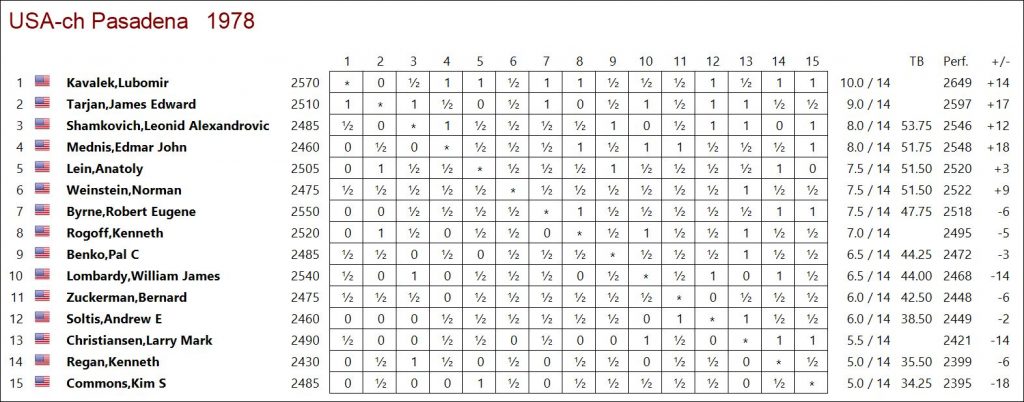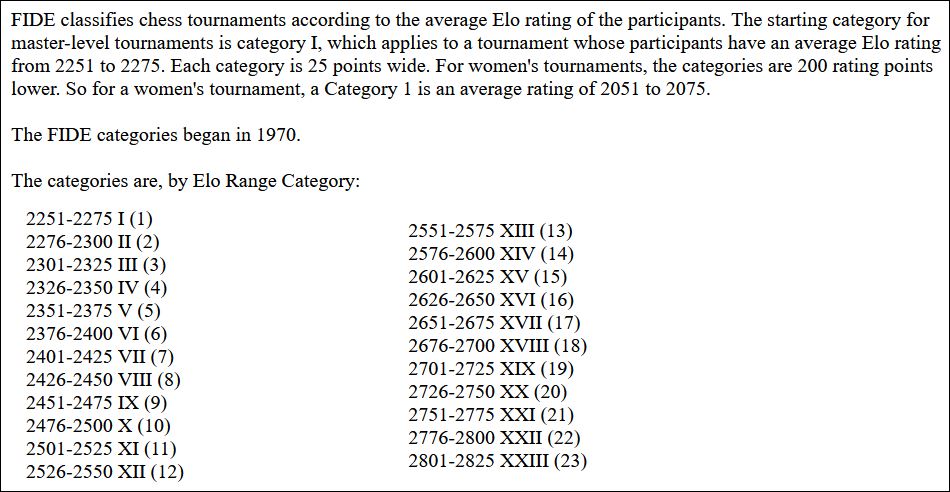
I didn’t know anything about Kavalek, In the back cover of this book it described him as a three times US champion, but once more I began playing around 2011, and he wasn’t on the chess scene, the names I heard were Nakamura, Caruana I think moved to Italy at that time, Shankland, etc. Kavalek won twice also the national championship of his native country, in that time called: Czechoslovakia, in 1962 and 1968. This is something which caught my attention, because I know in that time there were no computers helping us learning chess, no tactics site, to become a good chess player, which showed Kavalek definitely used all his time and energies on chess, Kavalek got his IM and GM titles in 1965, one definitely had to be good. Why? Because FIDE began to give GM titles in the 1950ies, and in 1965-70ies there were in the entire world something like 70-80 humans who reached that level, hence the GM title was really important. I think today we have more than 1600.
I checked his victory in the Czechoslovakia’s championship in 1962, and I was impressed, the tournament was 17 rounds!! In that time there were adjournments, which means after move 40 the players could put a move in an envelope and play the endgame the day after, while analyzing all night long.

Here the games played by Kavalek in 1962, we can see his play was quite sharp with queen sacs and other tactics played all the time:
Watching all the games played by Kavalek in this tournament, one can have the feeling that the Sicilian is definitely a killer opening, so yes there is a lot of theory to study, but it’s razor level sharp. New in Chess and GM Giri just published a book with a Sicilian Dragon repertoire.

This is the results for the Czechoslovakia’s championship of 1968:

And these are the games:
Always reading the back cover, they write he was a good chess writer, because he wrote columns for the Washingtn Post and Huffington Post.

Here a picture from the first time Kavalek was using the US flag against Karpov, likely in the 1970 Caracas tournament, which Kavalek won ahead of Karpov!
While reading the book, I began to pay attention and discover more about Kavalek.
In this sense I’m really grateful to New in Chess, because generally we only discover the main chess players like Fischer, Karpov, Kasparov, while minor one like Kavalek disappear. Instead thanks to this book I greatly increased my chess knowledge. For example did you know that Kavalek won a tournament in Caracas in 1970, ahead and beating Karpov the then Youth World Champion, and of Stein?
Here the crosstable:

Please watch the games he played, watch the one in which he smashed Karpov! And of course don’t miss the game against Villaroel, Kavalek was able to win without playing 1 move! He was clearly the Magician from Prague!
Reading this book made me enjoy the many stories of strong players I knew nothing about: Szabo a famous Hungarian champion was a Russian prisoner of war, returning home with a weight of 45 kgs!
I believe this book is important because it’s a work of love, the wife had to translate it because Kavalek unfortunately died before he could finish it. The people who loved him, for example one of his chess students, found the games (47 in total) we can enjoy at the end of the book. In our modern world, we can benefit from the collaboration of different people, to acquire a book like this which would otherwise been lost.
The book can be also a guide for players interested in chess improvement. For example at page 15 one of the famous chess trainers of that time gave a great advice to Kavalek and other kids visiting him in the quarter of the chess federation.
Kavalek recounts also one common chess obsession with chess players, we do love to collect chess books, it seems he had something like 5000! But three in particular caught my attention, and the fact that Kavalek, like Larsen and other top GMs of his period all grew up reading those three books makes them important for each chess player who is interested in improving.
Some of the stories are funny for the difference in mindset with today. It seems Kavalek spent a summer as a 12-13 years old in a filled by cigarette smoke environment, a pub (I doubt here in US would let a child in a pub, especially one full of second hand cigarette smoke) where he played chess with older players, with the blessing of his grandparents!
And of course there are more interesting events re-counted by Kavalek. For example one of his mentors who played with him often, guested Alekhine in 1933, while Alekhine was on a simul tour all over Czechoslovakia. Alekhine would play 50 opponents every evening. The tour lasted 31 days, in which Alekhine played 1402 games!
The book mentions a lot of important games Kavalek has studied or seen during his career. It would be important to follow the book with Chessbase 16 (soon 17!) and Megabase open, because one can see the evolution of some lines of the Sicilian Najdorf or the beauty of the games Kavalek was witnessing in those years.
In the west we often hear the word “karma” obviously I’m not a Buddhist scholar or a hindu of the priest caste, but I found something quite interesting in the book. At page 26 Kavalek mentions that GM Pachman, famous for his middlegame books, was a rabid communist who destroyed many lives. But I remember that Pachman escaped from communism, in fact I checked Wikipedia where one can read: “In 1972, after being imprisoned and tortured almost to death by the Communist regime in Czechoslovakia, he was allowed to emigrate to West Germany.” I guess this could be an example of karma in action?
Pro and Con: The book doesn’t have tables with Kavalek’s tournament results, but there is a section at the end of the book with a list of tournaments in which Kavalek played and the result. Yet it’s nice to see the table of the final results, because one can see who were the opponents, and how they fared:

Sometimes can be daunting to understand what they mean, like at page 225 is given the result of the 1958 club championship, and Kavalek writes: at the time I was a Category 2 player.
Honestly I didn’t have any idea what it meant, many national federations have different standards to define players. So I looked in Internet and found an article of Bill Wall, which gives the following explanation:

To give a comparison with the United States Chess Federation system, once more from Bill Wall article:

The book is hard cover, and is quite nice, because it opens well. New in Chess lately has made more hard cover books, some in previous years were biographies of past chess players, this will be a great add to my library.

This book has a lot of pictures, and this is definitely great, because one can appreciate the key moment of GM Kavalek’s life.
There are some phrases which can be confusing, and maybe should be re-written in another edition of the book, for example at page 14:
“His teacher was the famous Russian Grandmaster Efim Bogoljubow who lived in Germany and in the 1930s, Stoltz played two matches against the World Champion Alexander Alekhine.”
The statement above would make one think “Stoltz” played world championship matches against Alekhine, but it’s Bogoljubow who played. Hence “Stoltz” was likely inserted by mistake.
Always at page 14 it’s mentioned a beautiful game played by Stoltz vs Spielmann. Maybe the editor could have thought to kindly add the game, so one could replay it over the chess board while reading the book.
Here the game for those who love chess and like to connect the dots between what an author writes and the names and games mentioned:
Watching this game one can think that Spielmann wasn’t exposed to Morphy enough!
Final Thoughts: the book is really a pleasant read. It paints vignettes from the life of a chess player who lived in WWII, under Communism, and then finally in the west. A chess player who experienced both sides. His experiences, dreams, accomplishments, disappointments, and much more is collected in this book. Practically thanks to this book one can travel in time, and follow the author in different years, places, tournaments and historical characters Kavalek met and interacted with.
Chess is amazing, because it is a sport, which we can practice throughout our lives (also if of course, after a certain age there is a decline like in every sport) and then there is the human side we can enjoy. In this case this is the book one wants to bring on vacation, enjoying it on a beach. And then of course in the evening one can take out the chess board and replay some of the games.
